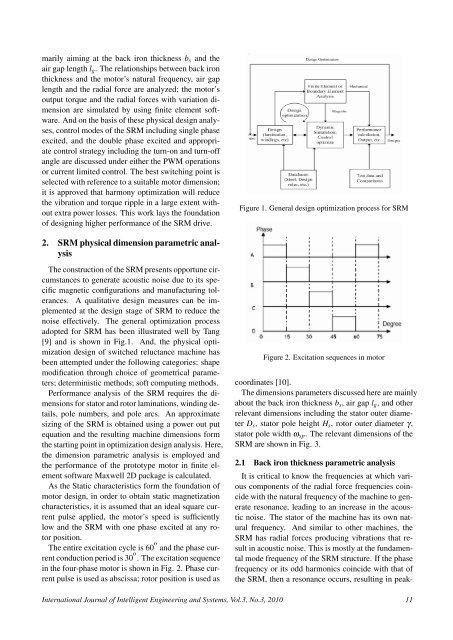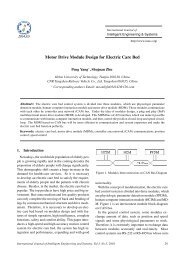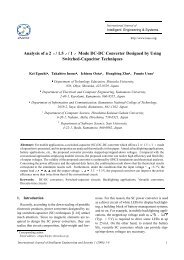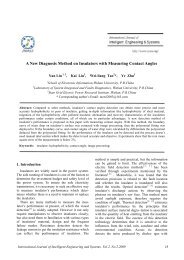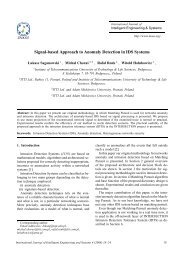Harmony Optimization Design of Switched Reluctance Motor ... - inass
Harmony Optimization Design of Switched Reluctance Motor ... - inass
Harmony Optimization Design of Switched Reluctance Motor ... - inass
You also want an ePaper? Increase the reach of your titles
YUMPU automatically turns print PDFs into web optimized ePapers that Google loves.
marily aiming at the back iron thickness b s and the<br />
air gap length l g . The relationships between back iron<br />
thickness and the motor’s natural frequency, air gap<br />
length and the radial force are analyzed; the motor’s<br />
output torque and the radial forces with variation dimension<br />
are simulated by using finite element s<strong>of</strong>tware.<br />
And on the basis <strong>of</strong> these physical design analyses,<br />
control modes <strong>of</strong> the SRM including single phase<br />
excited, and the double phase excited and appropriate<br />
control strategy including the turn-on and turn-<strong>of</strong>f<br />
angle are discussed under either the PWM operations<br />
or current limited control. The best switching point is<br />
selected with reference to a suitable motor dimension;<br />
it is approved that harmony optimization will reduce<br />
the vibration and torque ripple in a large extent without<br />
extra power losses. This work lays the foundation<br />
<strong>of</strong> designing higher performance <strong>of</strong> the SRM drive.<br />
Figure 1. General design optimization process for SRM<br />
2. SRM physical dimension parametric analysis<br />
The construction <strong>of</strong> the SRM presents opportune circumstances<br />
to generate acoustic noise due to its specific<br />
magnetic configurations and manufacturing tolerances.<br />
A qualitative design measures can be implemented<br />
at the design stage <strong>of</strong> SRM to reduce the<br />
noise effectively. The general optimization process<br />
adopted for SRM has been illustrated well by Tang<br />
[9] and is shown in Fig.1. And, the physical optimization<br />
design <strong>of</strong> switched reluctance machine has<br />
been attempted under the following categories: shape<br />
modification through choice <strong>of</strong> geometrical parameters;<br />
deterministic methods; s<strong>of</strong>t computing methods.<br />
Performance analysis <strong>of</strong> the SRM requires the dimensions<br />
for stator and rotor laminations, winding details,<br />
pole numbers, and pole arcs. An approximate<br />
sizing <strong>of</strong> the SRM is obtained using a power out put<br />
equation and the resulting machine dimensions form<br />
the starting point in optimization design analysis. Here,<br />
the dimension parametric analysis is employed and<br />
the performance <strong>of</strong> the prototype motor in finite element<br />
s<strong>of</strong>tware Maxwell 2D package is calculated.<br />
As the Static characteristics form the foundation <strong>of</strong><br />
motor design, in order to obtain static magnetization<br />
characteristics, it is assumed that an ideal square current<br />
pulse applied, the motor’s speed is sufficiently<br />
low and the SRM with one phase excited at any rotor<br />
position.<br />
The entire excitation cycle is 60 o and the phase current<br />
conduction period is 30 o . The excitation sequence<br />
in the four-phase motor is shown in Fig. 2. Phase current<br />
pulse is used as abscissa; rotor position is used as<br />
Figure 2. Excitation sequences in motor<br />
coordinates [10].<br />
The dimensions parameters discussed here are mainly<br />
about the back iron thickness b s , air gap l g , and other<br />
relevant dimensions including the stator outer diameter<br />
D s , stator pole height H s , rotor outer diameter γ,<br />
stator pole width ω sp . The relevant dimensions <strong>of</strong> the<br />
SRM are shown in Fig. 3.<br />
2.1 Back iron thickness parametric analysis<br />
It is critical to know the frequencies at which various<br />
components <strong>of</strong> the radial force frequencies coincide<br />
with the natural frequency <strong>of</strong> the machine to generate<br />
resonance, leading to an increase in the acoustic<br />
noise. The stator <strong>of</strong> the machine has its own natural<br />
frequency. And similar to other machines, the<br />
SRM has radial forces producing vibrations that result<br />
in acoustic noise. This is mostly at the fundamental<br />
mode frequency <strong>of</strong> the SRM structure. If the phase<br />
frequency or its odd harmonics coincide with that <strong>of</strong><br />
the SRM, then a resonance occurs, resulting in peak-<br />
International Journal <strong>of</strong> Intelligent Engineering and Systems, Vol.3, No.3, 2010 11


